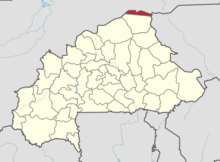Christmas War
| Agacher Strip War | |||||||||
|---|---|---|---|---|---|---|---|---|---|
 Map of Burkina Faso with the Agacher Strip highlighted in red |
|||||||||
|
|||||||||
| Belligerents | |||||||||
|
|
|
||||||||
| Commanders and leaders | |||||||||
| Moussa Traore | Thomas Sankara | ||||||||
| Strength | |||||||||
| 7,600 | 4,600 | ||||||||
| Casualties and losses | |||||||||
| 38 killed 57 wounded |
141 killed 257 wounded |
||||||||
| 59-300 killed in total | |||||||||
Ceasefire
The Agacher Strip War was fought over a 100-mile (160 km) long strip of land located in northern Burkina Faso, in the province of Gorom-Gorom. The area, thought to contain considerable amounts of natural gas and mineral resources, was the center of a long running border dispute between Upper Volta (renamed Burkina Faso in 1984) and Mali, which erupted into an armed conflict on two occasions (in 1974 and 1985).
The Agacher Strip was thought to contain substantial natural resources. Both sides hoped that the exploitation of these resources would help improve the dire economic situations in their respective countries.
Some observers believe that the dispute may have been deliberately provoked to divert attention from domestic problems brought on by the return of military rule in Upper Volta, and the growing unpopularity of Moussa Traoré's military regime in Mali.
The dispute between the two countries first erupted into an armed conflict on 25 November 1974. The conflict was characterized by a lack of military operations or any significant fighting. Only a few border skirmishes that involved exchanges of small arms fire were reported in late November and mid-December 1974. Casualties on both sides were minimal.
Mediation efforts by President Gnassingbé Eyadéma of Togo and President Seyni Kountché of Niger to resolve the conflict were unsuccessful and sporadic clashes continued into early 1975. As tensions escalated, numerous reprisals against Malians in Upper Volta were reported. This prompted the Organization of African Unity to create a commission to mediate the crisis. The mediators recommended that a neutral technical commission be set up to demarcate the boundary. At a meeting held on 18 June 1975 in Lomé, Togo, both sides accepted the proposal.
From 1977, Upper Volta and Mali engaged in political mediation within a regional West African group known as the Non-Aggression and Defense Aid Agreement (ANAD).
In 1983, military captain Thomas Sankara instigated a coup and seized power in Burkina Faso, and was tasked with resolving the country's many problems, including the Agacher Strip dispute. The relations between the two countries were already deteriorated when Drissa Keita, a Malian diplomat in Burkina Faso, was expelled. The two presidents, Sankara and Moussa Traoré, also had strained relations for a while. Negotiations between the countries' top diplomats failed, and the dispute further escalated. Some Burkina Faso newspapers accused Mali of preparing an invasion; Mali rejected the accusations and accused Burkina Faso of escalating tensions. By 1985, both countries had experienced several years of drought. Rainfall finally came in late 1985, but it washed out roads and hindered distribution of food and medical supplies to the region. During this period, the Burkinabé government organized a nationwide census. The census agents visited Fula camps in Mali, which sparked outrage from the Malian government, who saw it as a violation of their sovereignty. Reports were made that Burkinabé ground troops were present in the Agacher Strip, as Burkina Faso believed they had sovereignty over the area, and that no formal deal had been made up to that point. Malian President Traoré publicly denounced the act, and for ten days asked African leaders to pressure Sankara. However, the Burkinabé soldiers did not leave the area, and tensions grew further.
...
Wikipedia
